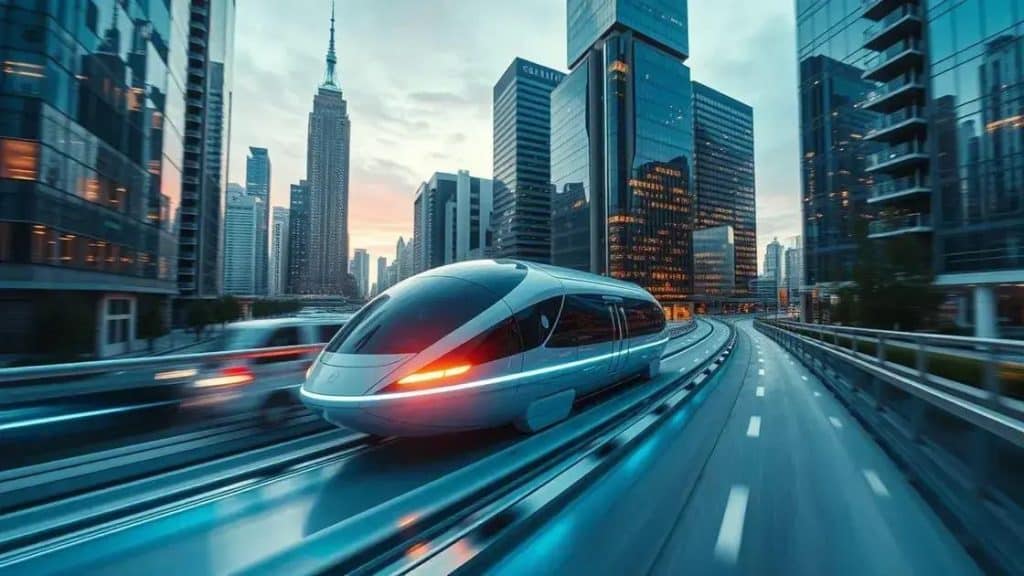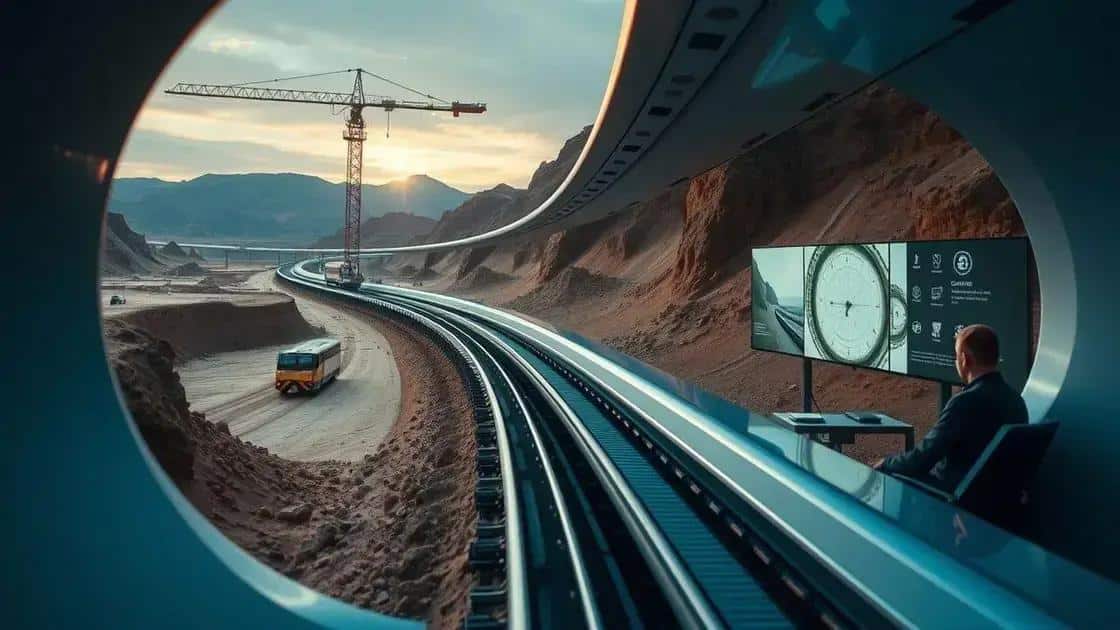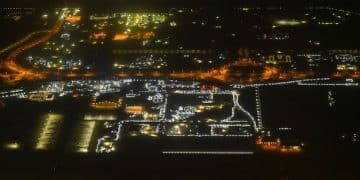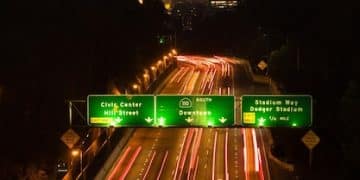Advancements in hyperloop transportation systems are changing travel

Advancements in hyperloop transportation systems promise faster, more efficient travel between cities while facing challenges like high costs, regulatory hurdles, and public acceptance.
Advancements in hyperloop transportation systems are poised to transform how we travel. Imagine whisking across cities at incredible speeds—doesn’t that sound exciting? In this article, we’ll delve into the groundbreaking progress being made.
Understanding hyperloop technology
Hyperloop technology is an innovative mode of transportation that promises to change how we travel between cities. By using a vacuum-sealed tube, pods can travel at high speeds with minimal air resistance. This could mean reaching your destination faster than ever before.
Many are curious about how this technology works. It operates on the principle of magnetic levitation, which allows the pods to glide smoothly without touching the tracks. This feature not only enhances speed but also reduces wear and tear on the system.
Key Components of Hyperloop
To better understand hyperloop technology, it’s essential to know the main components that make it possible:
- Vacuum Tubes: These tubes minimize air resistance.
- Pods: The vehicles designed to carry passengers or cargo.
- Magnetic Levitation: A technology that enables the pods to hover above the track.
- Energy Systems: Efficient power sources that keep the hyperloop running smoothly.
Each component plays a crucial role in making hyperloop travel fast and efficient. Moreover, the technology is designed with safety in mind, employing various systems to ensure secure travel for passengers.
As we explore hyperloop technology, it’s vital to consider the environmental impact as well. By using renewable energy sources, hyperloop systems can reduce carbon emissions compared to traditional transportation methods. This commitment to sustainability is a significant advantage in today’s world, where environmental awareness is crucial.
With numerous companies working on developing hyperloop systems globally, we could soon see these futuristic travel methods in action. The advancements in technology are rapid, and the potential for a hyperloop network could transform not only travel times but also the way we connect across great distances.
Benefits of hyperloop transportation

The benefits of hyperloop transportation are immense and can significantly impact how we travel. This new mode of transport promises not only speed but also efficiency. Imagine getting from one city to another in a fraction of the time it takes today!
One major benefit is the potential for reduced travel times. Hyperloop systems are designed to operate at speeds exceeding 600 miles per hour, which means long distances can be covered quickly. For instance, a trip that currently takes several hours could be reduced to mere minutes.
Environmental Advantages
Another significant advantage of hyperloop technology is its environmental impact. By utilizing renewable energy sources, hyperloop systems can reduce carbon emissions. In addition, the streamlined design of the pods and tubes minimizes energy consumption, promoting sustainability.
- Lower Energy Costs: Efficient energy use leads to cheaper operating costs.
- Reduced Congestion: Hyperloop systems can alleviate traffic jams by moving large numbers of passengers swiftly.
- Minimal Land Use: This technology requires less land compared to traditional rail and roads, preserving more natural habitats.
Moreover, hyperloop transportation can boost economic growth. Faster travel enables better connectivity between cities, which can lead to increased tourism and business opportunities. Places that were once considered remote could become more accessible, fostering local economies.
The safety aspect of hyperloop technology is also paramount. With advanced engineering, the systems are designed to withstand various conditions. This means safer travel for passengers, which is a crucial consideration as we look towards the future of transportation.
Current projects worldwide
Current hyperloop projects worldwide are at the forefront of transportation innovation. Many countries are exploring this promising technology, each with unique approaches and timelines. From the United States to Europe and Asia, the race to implement hyperloop systems is gaining momentum.
In the United States, several companies are leading the charge. For example, Virgin Hyperloop has made significant strides with its test facility in Nevada. Here, they’ve successfully conducted passenger tests, showcasing the potential for future travel. Other companies like Hyperloop One are exploring routes that could link major cities, significantly cutting down travel time.
International Initiatives
Outside the U.S., countries around the globe are also getting involved. In India, plans are being developed for a hyperloop line that connects Mumbai and Pune, which would drastically reduce the journey time to around 25 minutes. The Indian government supports this initiative, recognizing the potential benefits for its growing economy.
- Europe: The European Union has expressed interest in hyperloop technology, with various projects proposed in countries like Spain and France.
- Canada: Canadian companies are exploring hyperloop routes in provinces such as Ontario, with ambitions to link major urban centers.
- UAE: The United Arab Emirates is also exploring the possibility of a hyperloop connecting Dubai and Abu Dhabi, aiming to enhance tourism and business connections.
These projects not only highlight the widespread interest in hyperloop technology but also indicate a global shift towards efficient travel solutions. The design and engineering challenges are significant, but the commitment to making this transformative transportation method a reality is evident in these ongoing efforts.
Moreover, partnerships between governments and private companies are crucial for the success of these initiatives. Collaborative efforts are paving the way for regulatory frameworks that could support the development of hyperloop systems, ensuring safety and efficiency.
Challenges facing hyperloop systems

Despite the excitement around hyperloop technology, there are significant challenges facing hyperloop systems that need to be addressed. These obstacles have the potential to impact the timeline and feasibility of this groundbreaking form of transportation. Understanding these challenges is critical as we move forward.
One primary challenge is the high cost of development. Building the infrastructure for a hyperloop system requires substantial investment. This encompasses the costs of constructing vacuum tubes, developing pods, and ensuring safety measures are in place. Many companies are seeking funding through private investments and government partnerships to overcome this hurdle.
Regulatory and Safety Concerns
In addition to financial challenges, regulatory hurdles are significant. Each region has different laws governing transportation, and creating a new system like hyperloop necessitates compliance with existing regulations. Companies must work closely with governments to ensure safety standards meet expectations.
- Safety Tests: Thorough testing is essential to demonstrate the technology’s reliability.
- Public Acceptance: Gaining public trust is crucial for widespread adoption.
- Environmental Impact Studies: Assessing and minimizing the environmental effects is a necessary step.
Moreover, engineering challenges present obstacles. Designing a hyperloop that operates safely at high speeds in low-pressure environments requires advanced technology and expertise. Engineers face intricate tasks, such as ensuring the structural integrity of the tubes and developing systems to manage passenger safety during operation.
Another issue is land acquisition. Securing land for the hyperloop routes can lead to conflicts with local communities and environmental groups. Resistance from residents concerned about changes in their neighborhoods can delay or derail projects altogether. Navigating these social dimensions demands sensitivity and effective communication.
Finally, competition among various hyperloop companies can also impact progress. Each company is racing to deploy their technology, which can lead to rushed decisions and potential oversights. This competition may also drive innovation but can dilute focus on ensuring safety and reliability, which are paramount in transportation infrastructure.
In summary, while hyperloop technology brings exciting possibilities for the future of transportation, it is crucial to recognize the challenges it faces. Developing this innovative system requires significant investment, careful planning, and collaboration among various stakeholders. Successfully addressing the financial, regulatory, engineering, and social challenges will be paramount to realizing the potential benefits that hyperloop transportation can offer. As the industry evolves, keeping safety, efficiency, and environmental impact in focus will ensure that hyperloop can transform the way we travel. The journey to a hyperloop future may be complex, but with perseverance and innovation, it can become a reality that changes the landscape of travel forever.
FAQ – Frequently Asked Questions about Hyperloop Transportation
What is hyperloop technology?
Hyperloop technology is a new form of transportation that uses vacuum-sealed tubes to transport pods at high speeds, aimed at reducing travel times between cities.
What are the main benefits of hyperloop systems?
The main benefits include faster travel times, reduced environmental impact, and increased economic growth by connecting major urban areas.
What challenges does hyperloop face?
Challenges include high development costs, regulatory hurdles, engineering complexities, and the need for public acceptance.
Where are hyperloop projects currently being developed?
Current projects are underway in the US, India, UAE, and several European countries, with various companies working on different routes and technology.





